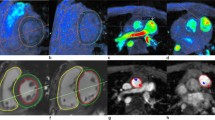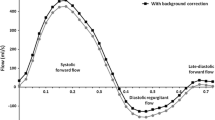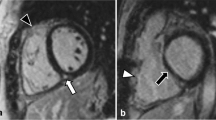Summary
Aims
QRS prolongation is a negative prognostic factor for the development of ventricular arrhythmia after repair of tetralogy of Fallot (TOF). In this MRI study, we performed a multivariate analysis to determine the influence of volumetric and functional parameters as well as time factors on QRS duration.
Methods and results
Sixty-seven patients after surgical repair of TOF were studied using a 1.5T MRI. Measurement of the ventricles was performed with a multislice-multiphase sequence. Left and right ventricular volumes, ejection fractions (EF) and myocardial masses were determined. Pulmonary regurgitant fraction (PRF) was quantified by velocity encoded flow measurement in the main pulmonary artery. Maximum QRS duration was taken from a 12-channel ECG. Mean maximum QRS duration was 132 ms (± 29 ms). Mean PRF was 29.2% (± 13.4%). QRS duration correlated significantly with PRF (r = 0.49; p < 0.01; n = 54) and with right ventricular enddiastolic volume index (RVEDVI) (r = 0.29; p < 0.05; n = 67). Multivariate analysis revealed that the combination of PRF, postoperative period, age at surgical repair, and left ventricular (LV) enddiastolic volume are correlated with QRS prolongation.
Conclusion
– In patients after repair of TOF, pulmonary regurgitation is related to QRS prolongation. Furthermore, even LV size plays a role in the enlargement of the QRS complex.
Similar content being viewed by others
References
Reddy VM, Liddicoat JR, McElhinney DB, Brook MM, Stanger P, Hanley FL (1995) Routine primary repair of tetralogy of Fallot in neonates and infants less than three months of age. Ann Thorac Surg 60:S592–596
Norgaard MA, Lauridsen P, Helvind M, Pettersson G (1999) Twenty-tothirty- seven-year follow-up after repair for Tetralogy of Fallot. Eur J Cardiothorac Surg 16:125–130
Hennein HA, Mosca RS, Urcelay G, Crowley DC, Bove EL (1995) Intermediate results after complete repair of tetralogy of Fallot in neonates. J Thorac Cardiovasc Surg 109:332–342, 344; discussion 342–333
Wolff GS, Rowland TW, Ellison RC (1972) Surgically induced right bundle- branch block with left anterior hemiblock. An ominous sign in postoperative tetralogy of Fallot. Circulation 46:587–594
de Ruijter FT, Weenink I, Hitchcock FJ, Meijboom EJ, Bennink GB (2002) Right ventricular dysfunction and pulmonary valve replacement after correction of tetralogy of Fallot. Ann Thorac Surg 73:1794–1800; discussion 1800
Borowski A, Ghodsizad A, Litmathe J, Lawrenz W, Schmidt KG, Gams E (2004) Severe pulmonary regurgitation late after total repair of tetralogy of Fallot: surgical considerations. Pediatr Cardiol 25:466–471
Gatzoulis MA, Till JA, Somerville J, Redington AN (1995) Mechanoelectrical interaction in tetralogy of Fallot. QRS prolongation relates to right ventricular size and predicts malignant ventricular arrhythmias and sudden death. Circulation 92:231–237
Gatzoulis MA, Balaji S, Webber SA et al (2000) Risk factors for arrhythmia and sudden cardiac death late after repair of tetralogy of Fallot: a multicentre study. Lancet 356:975–981
van Huysduynen BH, van Straten A, Swenne CA et al (2005) Reduction of QRS duration after pulmonary valve replacement in adult Fallot patients is related to reduction of right ventricular volume. Eur Heart J 26:928–932
Helbing WA, Roest AA, Niezen RA et al (2002) ECG predictors of ventricular arrhythmias and biventricular size and wall mass in tetralogy of Fallot with pulmonary regurgitation. Heart 88:515–519
Helbing WA, Rebergen SA, Maliepaard C et al (1995) Quantification of right ventricular function with magnetic resonance imaging in children with normal hearts and with congenital heart disease. Am Heart J 130:828–837
Jacoby C, Molojavyi A, Flogel U, Merx MW, Ding Z, Schrader J (2006) Direct comparison of magnetic resonance imaging and conductance microcatheter in the evaluation of left ventricular function in mice. Basic Res Cardiol 101:87–95
Gutberlet M, Abdul-Khaliq H, Grothoff M et al (2003) Evaluation of left ventricular volumes in patients with congenital heart disease and abnormal left ventricular geometry. Comparison of MRI and transthoracic 3- dimensional echocardiography. Rofo 175:942–951
Niezen RA, Helbing WA, van der Wall EE, van der Geest RJ, Rebergen SA, de Roos A (1996) Biventricular systolic function and mass studied with MR imaging in children with pulmonary regurgitation after repair for tetralogy of Fallot. Radiology 201:135–140
Lorenz CH (2000) The range of normal values of cardiovascular structures in infants, children, and adolescents measured by magnetic resonance imaging. Pediatr Cardiol 21:37–46
Vogel M, Gutberlet M, Dittrich S, Hosten N, Lange PE (1997) Comparison of transthoracic three dimensional echocardiography with magnetic resonance imaging in the assessment of right ventricular volume and mass. Heart 78:127–130
Lotz J, Meier C, Leppert A, Galanski M (2002) Cardiovascular flow measurement with phase-contrast MR imaging: basic facts and implementation. Radiographics 22:651–671
Bryant DJ, Payne JA, Firmin DN, Longmore DB (1984) Measurement of flow with NMR imaging using a gradient pulse and phase difference technique. J Comput Assist Tomogr 8:588–593
Agresti A (1990) Categorial Data Analysis, New York
Trappe HJ (2006) New perspectives in arrhythmia and heart failure monitoring. Clin Res Cardiol 95:iii1–iii2
Res JC, Theuns DA, Jordaens L (2006) The role of remote monitoring in the reduction of inappropriate implantable cardioverter defibrillator therapies. Clin Res Cardiol 95(Suppl 3):iii17–iii21
Abd El Rahman MY, Abdul-Khaliq H, Vogel M, Alexi-Meskishvili V, Gutberlet M, Lange PE (2000) Relation between right ventricular enlargement, QRS duration, and right ventricular function in patients with tetralogy of Fallot and pulmonary regurgitation after surgical repair. Heart 84:416–420
Warner KG, O’Brien PK, Rhodes J, Kaur A, Robinson DA, Payne DD (2003) Expanding the indications for pulmonary valve replacement after repair of tetralogy of Fallot. Ann Thorac Surg 76:1066–1071; discussion 1071–1062
Rebergen SA, Chin JG, Ottenkamp J, van der Wall EE, de Roos A (1993) Pulmonary regurgitation in the late postoperative follow-up of tetralogy of Fallot. Volumetric quantitation by nuclear magnetic resonance velocity mapping. Circulation 88:2257–2266
Louie EK, Bieniarz T, Moore AM, Levitsky S (1990) Reduced atrial contribution to left ventricular filling in patients with severe tricuspid regurgitation after tricuspid valvulectomy: a Doppler echocardiographic study. J Am Coll Cardiol 16:1617–1624
Lin SS, Reynertson SI, Louie EK, Levitsky S (1994) Right ventricular volume overload results in depression of left ventricular ejection fraction. Implications for the surgical management of tricuspid valve disease. Circulation 90:II209–213
Davlouros PA, Kilner PJ, Hornung TS et al (2002) Right ventricular function in adults with repaired tetralogy of Fallot assessed with cardiovascular magnetic resonance imaging: detrimental role of right ventricular outflow aneurysms or akinesia and adverse right-to-left ventricular interaction. J Am Coll Cardiol 40:2044–2052
Bello D, Fieno DS, Kim RJ et al (2005) Infarct morphology identifies patients with substrate for sustained ventricular tachycardia. J Am Coll Cardiol 45:1104–1108
Author information
Authors and Affiliations
Corresponding author
Additional information
This work was supported in part by a grant of the BmBF, competence network – congenital heart disease
Rights and permissions
About this article
Cite this article
Grothoff, M., Spors, B., Abdul-Khaliq, H. et al. Pulmonary regurgitation is a powerful factor influencing QRS duration in patients after surgical repair of tetralogy of Fallot. Clin Res Cardiol 95, 643–649 (2006). https://doi.org/10.1007/s00392-006-0440-5
Received:
Accepted:
Published:
Issue Date:
DOI: https://doi.org/10.1007/s00392-006-0440-5




